Review of Quality Standards for Diagnostic Radiology and Implications
VerifiedAdded on 2022/08/25
|8
|1466
|16
Report
AI Summary
This report reviews the legislative/service framework concerning quality standards in diagnostic radiology. It explores the significance of these standards, focusing on their implications for professional practice, service delivery, and patient care. The introduction highlights the evolution of radiology and the importance of accreditation programs to ensure safety and performance. The report then delves into the significance of quality standards, discussing the potential for malpractice and the need for standardized norms. The implications for professional practice are examined, covering the control of processes, facility and environment, personnel, equipment, documents and records, and risk control and safety. The conclusion emphasizes the importance of a structured framework for guiding and supervising diagnostic radiology practices. The report references key publications in the field, providing a comprehensive overview of the topic.
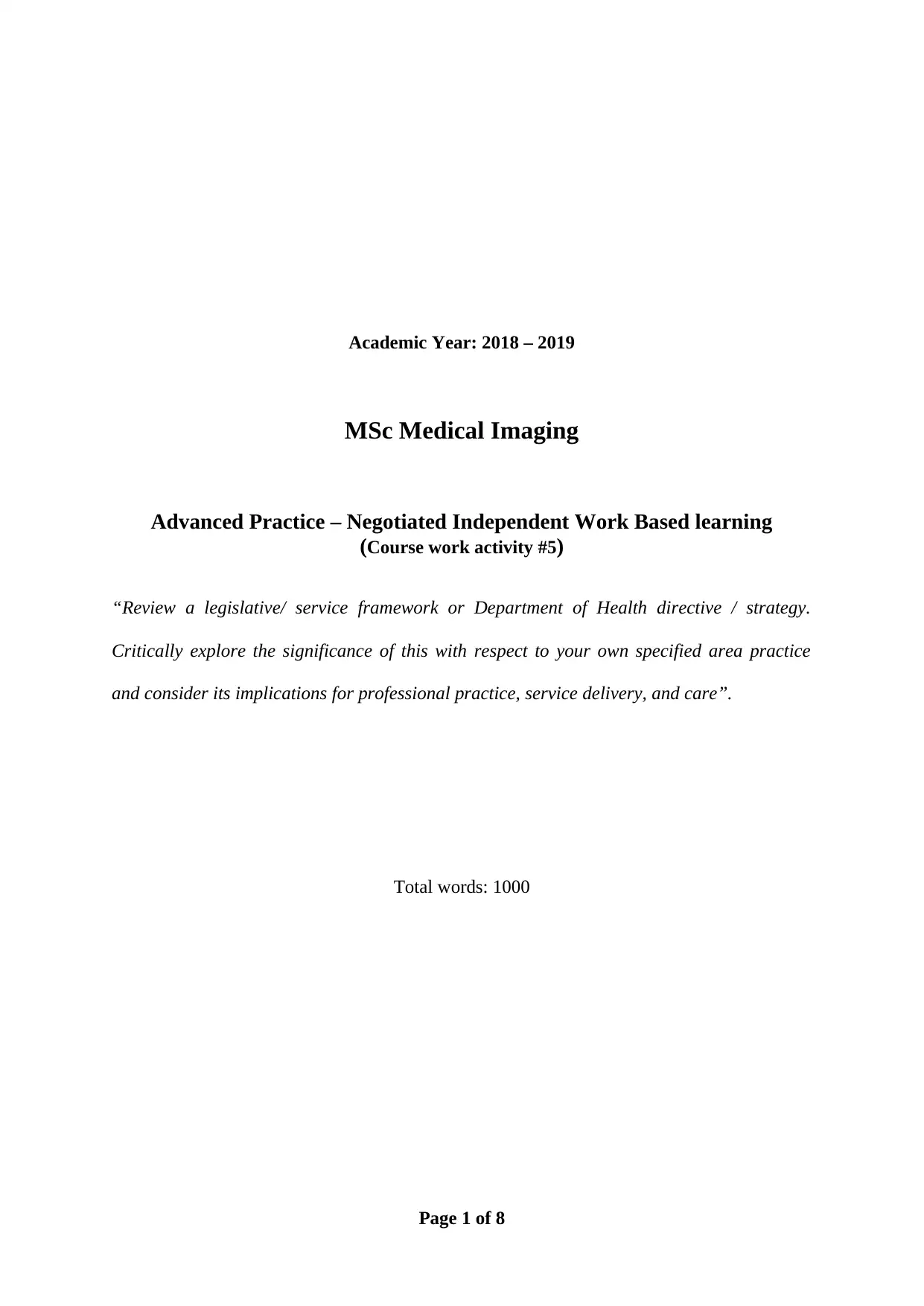
Academic Year: 2018 – 2019
MSc Medical Imaging
Advanced Practice – Negotiated Independent Work Based learning
(Course work activity #5)
“Review a legislative/ service framework or Department of Health directive / strategy.
Critically explore the significance of this with respect to your own specified area practice
and consider its implications for professional practice, service delivery, and care”.
Total words: 1000
Page 1 of 8
MSc Medical Imaging
Advanced Practice – Negotiated Independent Work Based learning
(Course work activity #5)
“Review a legislative/ service framework or Department of Health directive / strategy.
Critically explore the significance of this with respect to your own specified area practice
and consider its implications for professional practice, service delivery, and care”.
Total words: 1000
Page 1 of 8
Paraphrase This Document
Need a fresh take? Get an instant paraphrase of this document with our AI Paraphraser
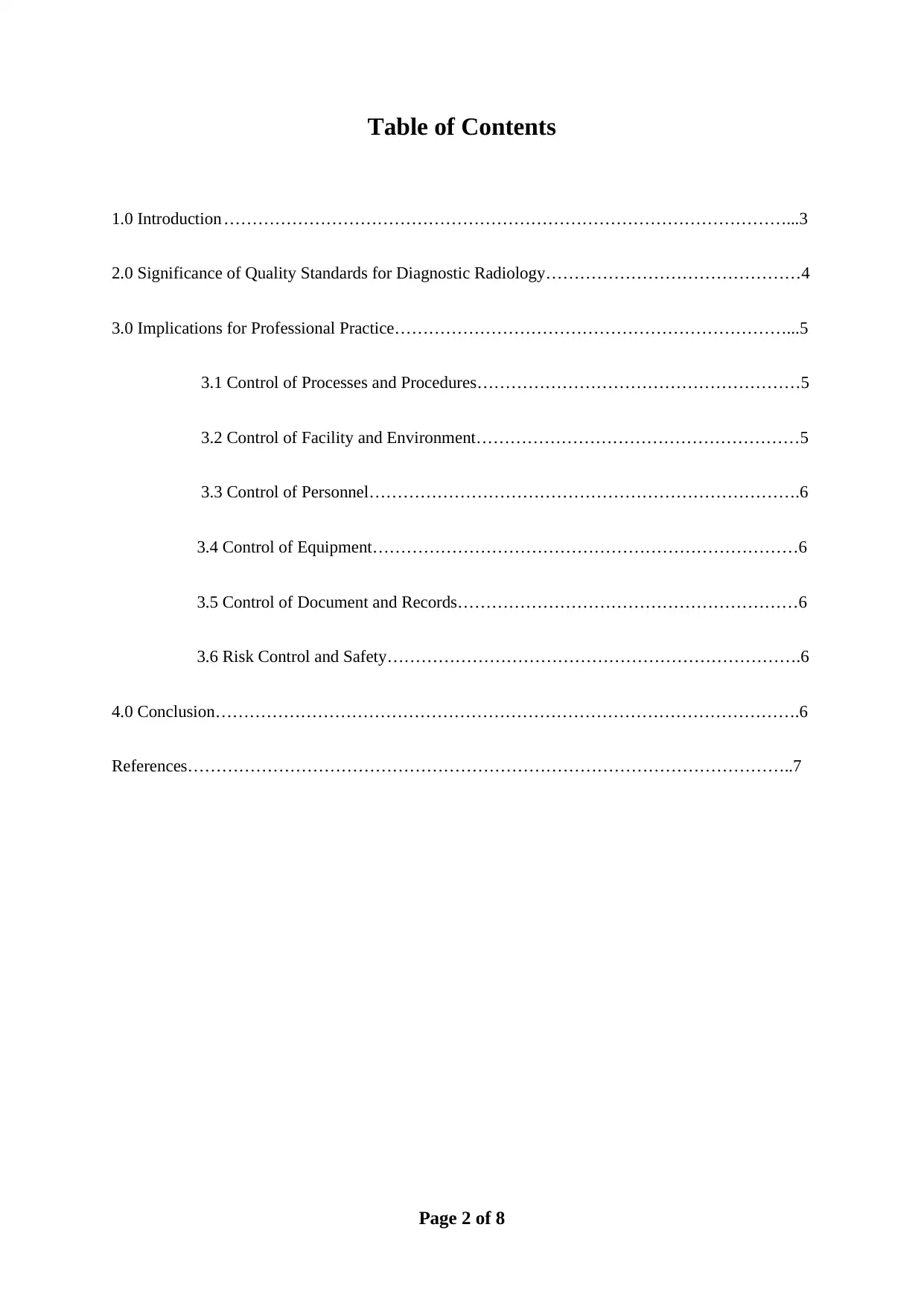
Table of Contents
1.0 Introduction ………………………………………………………………………………………...3
2.0 Significance of Quality Standards for Diagnostic Radiology………………………………………4
3.0 Implications for Professional Practice……………………………………………………………...5
3.1 Control of Processes and Procedures…………………………………………………5
3.2 Control of Facility and Environment…………………………………………………5
3.3 Control of Personnel………………………………………………………………….6
3.4 Control of Equipment…………………………………………………………………6
3.5 Control of Document and Records……………………………………………………6
3.6 Risk Control and Safety……………………………………………………………….6
4.0 Conclusion………………………………………………………………………………………….6
References……………………………………………………………………………………………..7
Page 2 of 8
1.0 Introduction ………………………………………………………………………………………...3
2.0 Significance of Quality Standards for Diagnostic Radiology………………………………………4
3.0 Implications for Professional Practice……………………………………………………………...5
3.1 Control of Processes and Procedures…………………………………………………5
3.2 Control of Facility and Environment…………………………………………………5
3.3 Control of Personnel………………………………………………………………….6
3.4 Control of Equipment…………………………………………………………………6
3.5 Control of Document and Records……………………………………………………6
3.6 Risk Control and Safety……………………………………………………………….6
4.0 Conclusion………………………………………………………………………………………….6
References……………………………………………………………………………………………..7
Page 2 of 8

1.0 Introduction
Radiology mainly encompasses the method of facilitating the medical imaging of clients in
order to display data that allows the diagnosis, therapy and avoidance of a medical condition
(Singh & Jayaram, 2015). Over the previous several centuries, the radiology domain has
experienced a enormous technology-driven revolution. The clinical advantages provided
through these techno-driven imaging procedures are humorous and have a significant effect
on critical decision-making at each nurse leadership stage. Nonetheless, it would entail
unjustified costs for national healthcare schemes if the performance of radiology facilities
does not suit ideal rates (Singh et al., 2016). Therefore, it was essential to introduce a
fundamental accreditation program in attempt to assess the amount of safety and performance
of diagnostic radiology facilities and describe a method for tracking the amount of
performance. This would be particular for the facilities of cardiac radiography. The quality
standards would represent what is anticipated from business suppliers and nurses in terms of
scanning radiology facilities that are great.
The Indian National Accreditation Committee is accountable for tracking the country's
medical imaging services. They have created and retained accreditation requirements for
diagnostic radiology facilities, with the primary objective of improving safety and precision
in aspects of radiology diagnosis (Madhusudan Singh et al., 2013). Such requirements can be
implemented to all health centres in tandem with norms created to calibrate test laboratories.
The aim of this document is to describe the importance of the diagnostic radiology service
structure and its implications for skilled exercise, distribution, and care.
Page 3 of 8
Radiology mainly encompasses the method of facilitating the medical imaging of clients in
order to display data that allows the diagnosis, therapy and avoidance of a medical condition
(Singh & Jayaram, 2015). Over the previous several centuries, the radiology domain has
experienced a enormous technology-driven revolution. The clinical advantages provided
through these techno-driven imaging procedures are humorous and have a significant effect
on critical decision-making at each nurse leadership stage. Nonetheless, it would entail
unjustified costs for national healthcare schemes if the performance of radiology facilities
does not suit ideal rates (Singh et al., 2016). Therefore, it was essential to introduce a
fundamental accreditation program in attempt to assess the amount of safety and performance
of diagnostic radiology facilities and describe a method for tracking the amount of
performance. This would be particular for the facilities of cardiac radiography. The quality
standards would represent what is anticipated from business suppliers and nurses in terms of
scanning radiology facilities that are great.
The Indian National Accreditation Committee is accountable for tracking the country's
medical imaging services. They have created and retained accreditation requirements for
diagnostic radiology facilities, with the primary objective of improving safety and precision
in aspects of radiology diagnosis (Madhusudan Singh et al., 2013). Such requirements can be
implemented to all health centres in tandem with norms created to calibrate test laboratories.
The aim of this document is to describe the importance of the diagnostic radiology service
structure and its implications for skilled exercise, distribution, and care.
Page 3 of 8
⊘ This is a preview!⊘
Do you want full access?
Subscribe today to unlock all pages.

Trusted by 1+ million students worldwide

2.0 Significance of Quality Standards for Diagnostic Radiology
The medical domain has gradually evolved into a company where personal teams and even
commercial buildings are now providing healthcare facilities. While the standard of treatment
has been significantly improved, there have also been cases of malpractice. Malpractice is not
limited solely to big healthcare suppliers, but it has also happened in other philanthropic and
non-profit undertakings. Healthcare malpractice is considered to happen when the specialist
concerned offers an inferior amount of treatment, resulting in injuries or harm to the person.
As far as radiology is concerned, let us assume a hypothetical situation in which the
radiologist failed to diagnose correctly a pulmonary nodule that was malignant and obviously
noticeable during the original neck X-ray (Singh & Jayaram, 2015). The cancer is untreated
as a consequence. The person succeeds after a few years due to comprehensive metastasis.
The radiologist would be kept liable for the patient's wrongful death in such a scenario. This
would be primarily owing to the reality that the person would have been encouraged to
pursue therapy by timely identification of the malignancy during the first X-ray. This can be
interpreted as an infringement of the recognized norm of radiological treatment as a specialist
field (Sohoni, 2013).
From this view, it becomes very essential to have a standardized norm for monitoring and
governing the provision of radiological facilities in India. Memorize that the National
Hospital and Healthcare Provider Accreditation Board (NABH) has described norms in mind.
These requirements were set for:-
Control of Processes and Procedures
Control of Facility and Environment
Control of Personnel
Page 4 of 8
The medical domain has gradually evolved into a company where personal teams and even
commercial buildings are now providing healthcare facilities. While the standard of treatment
has been significantly improved, there have also been cases of malpractice. Malpractice is not
limited solely to big healthcare suppliers, but it has also happened in other philanthropic and
non-profit undertakings. Healthcare malpractice is considered to happen when the specialist
concerned offers an inferior amount of treatment, resulting in injuries or harm to the person.
As far as radiology is concerned, let us assume a hypothetical situation in which the
radiologist failed to diagnose correctly a pulmonary nodule that was malignant and obviously
noticeable during the original neck X-ray (Singh & Jayaram, 2015). The cancer is untreated
as a consequence. The person succeeds after a few years due to comprehensive metastasis.
The radiologist would be kept liable for the patient's wrongful death in such a scenario. This
would be primarily owing to the reality that the person would have been encouraged to
pursue therapy by timely identification of the malignancy during the first X-ray. This can be
interpreted as an infringement of the recognized norm of radiological treatment as a specialist
field (Sohoni, 2013).
From this view, it becomes very essential to have a standardized norm for monitoring and
governing the provision of radiological facilities in India. Memorize that the National
Hospital and Healthcare Provider Accreditation Board (NABH) has described norms in mind.
These requirements were set for:-
Control of Processes and Procedures
Control of Facility and Environment
Control of Personnel
Page 4 of 8
Paraphrase This Document
Need a fresh take? Get an instant paraphrase of this document with our AI Paraphraser
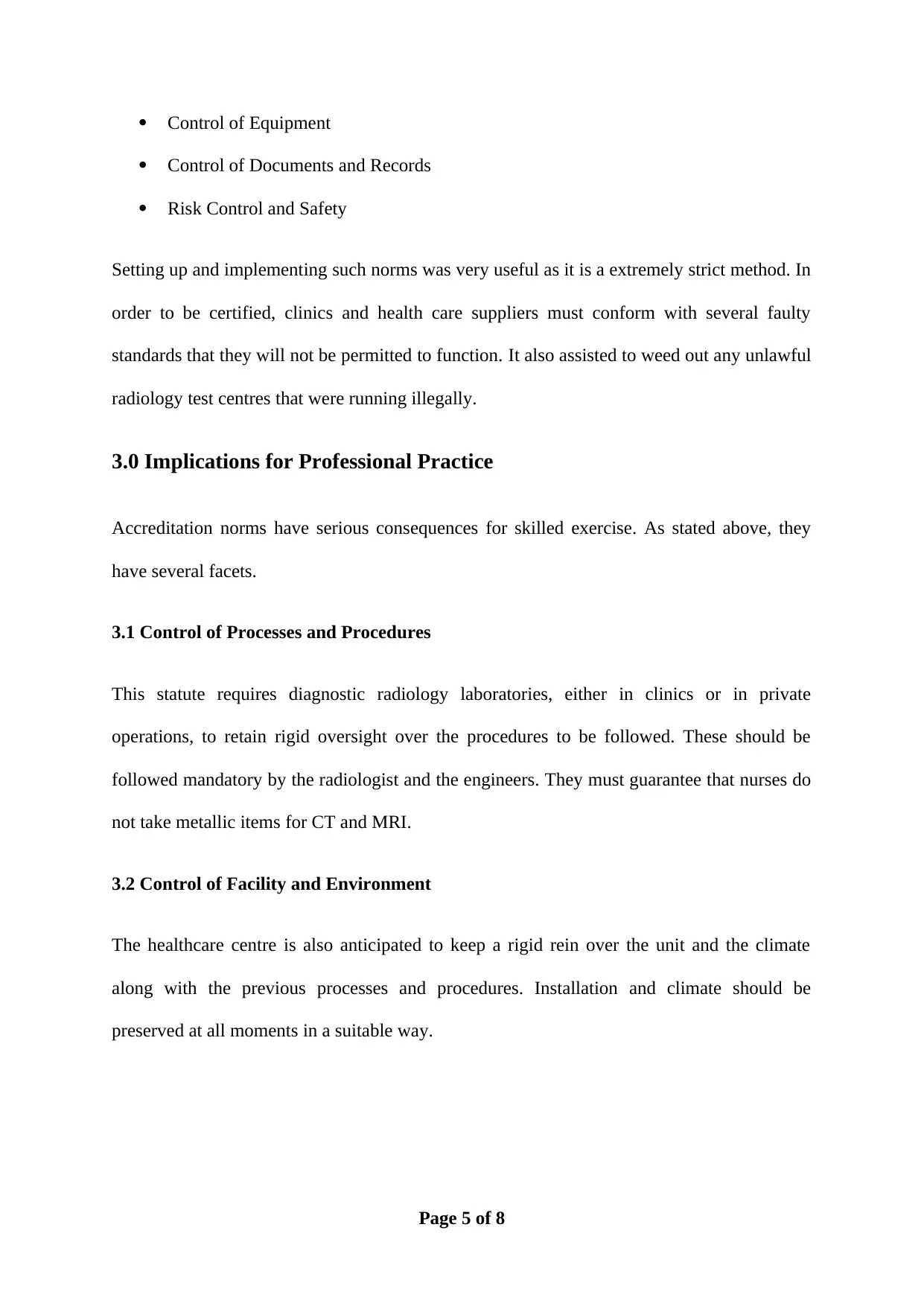
Control of Equipment
Control of Documents and Records
Risk Control and Safety
Setting up and implementing such norms was very useful as it is a extremely strict method. In
order to be certified, clinics and health care suppliers must conform with several faulty
standards that they will not be permitted to function. It also assisted to weed out any unlawful
radiology test centres that were running illegally.
3.0 Implications for Professional Practice
Accreditation norms have serious consequences for skilled exercise. As stated above, they
have several facets.
3.1 Control of Processes and Procedures
This statute requires diagnostic radiology laboratories, either in clinics or in private
operations, to retain rigid oversight over the procedures to be followed. These should be
followed mandatory by the radiologist and the engineers. They must guarantee that nurses do
not take metallic items for CT and MRI.
3.2 Control of Facility and Environment
The healthcare centre is also anticipated to keep a rigid rein over the unit and the climate
along with the previous processes and procedures. Installation and climate should be
preserved at all moments in a suitable way.
Page 5 of 8
Control of Documents and Records
Risk Control and Safety
Setting up and implementing such norms was very useful as it is a extremely strict method. In
order to be certified, clinics and health care suppliers must conform with several faulty
standards that they will not be permitted to function. It also assisted to weed out any unlawful
radiology test centres that were running illegally.
3.0 Implications for Professional Practice
Accreditation norms have serious consequences for skilled exercise. As stated above, they
have several facets.
3.1 Control of Processes and Procedures
This statute requires diagnostic radiology laboratories, either in clinics or in private
operations, to retain rigid oversight over the procedures to be followed. These should be
followed mandatory by the radiologist and the engineers. They must guarantee that nurses do
not take metallic items for CT and MRI.
3.2 Control of Facility and Environment
The healthcare centre is also anticipated to keep a rigid rein over the unit and the climate
along with the previous processes and procedures. Installation and climate should be
preserved at all moments in a suitable way.
Page 5 of 8
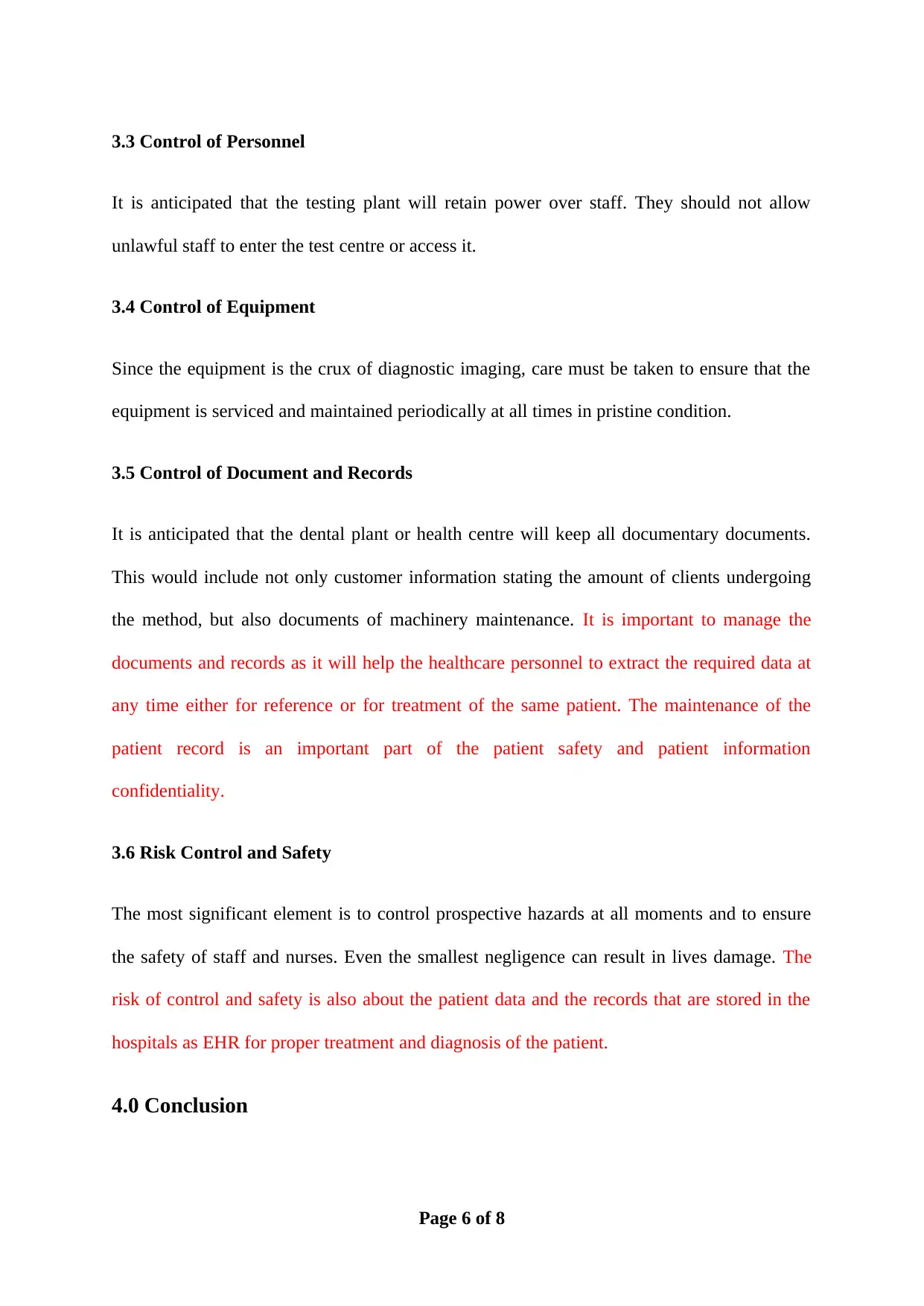
3.3 Control of Personnel
It is anticipated that the testing plant will retain power over staff. They should not allow
unlawful staff to enter the test centre or access it.
3.4 Control of Equipment
Since the equipment is the crux of diagnostic imaging, care must be taken to ensure that the
equipment is serviced and maintained periodically at all times in pristine condition.
3.5 Control of Document and Records
It is anticipated that the dental plant or health centre will keep all documentary documents.
This would include not only customer information stating the amount of clients undergoing
the method, but also documents of machinery maintenance. It is important to manage the
documents and records as it will help the healthcare personnel to extract the required data at
any time either for reference or for treatment of the same patient. The maintenance of the
patient record is an important part of the patient safety and patient information
confidentiality.
3.6 Risk Control and Safety
The most significant element is to control prospective hazards at all moments and to ensure
the safety of staff and nurses. Even the smallest negligence can result in lives damage. The
risk of control and safety is also about the patient data and the records that are stored in the
hospitals as EHR for proper treatment and diagnosis of the patient.
4.0 Conclusion
Page 6 of 8
It is anticipated that the testing plant will retain power over staff. They should not allow
unlawful staff to enter the test centre or access it.
3.4 Control of Equipment
Since the equipment is the crux of diagnostic imaging, care must be taken to ensure that the
equipment is serviced and maintained periodically at all times in pristine condition.
3.5 Control of Document and Records
It is anticipated that the dental plant or health centre will keep all documentary documents.
This would include not only customer information stating the amount of clients undergoing
the method, but also documents of machinery maintenance. It is important to manage the
documents and records as it will help the healthcare personnel to extract the required data at
any time either for reference or for treatment of the same patient. The maintenance of the
patient record is an important part of the patient safety and patient information
confidentiality.
3.6 Risk Control and Safety
The most significant element is to control prospective hazards at all moments and to ensure
the safety of staff and nurses. Even the smallest negligence can result in lives damage. The
risk of control and safety is also about the patient data and the records that are stored in the
hospitals as EHR for proper treatment and diagnosis of the patient.
4.0 Conclusion
Page 6 of 8
⊘ This is a preview!⊘
Do you want full access?
Subscribe today to unlock all pages.

Trusted by 1+ million students worldwide

Overall, a business structure is needed to direct, regulate and supervise how diagnostic
radiology facilities are performed and supplied within the country. After several iterations,
the current requirements have been completed and it is retained updated from moment to
moment with corrections. The current norms depict the professional judgement depending on
the debates and views of radiologist specialist boards as well as medical imaging provider
suppliers. The requirements were also thoroughly evaluated by an expert committee of
radiologists at an internal stage and also underwent comprehensive public consultation
previous to completion and implementation.
References
Madhusudan Singh, M., Shankar Garg, U. & Arora, P. (2013). Laws Applicable to Medical
Practice and Hospitals in India S. Kumar Gupta & S. Kant (eds.). International Journal
of Research Foundation of Hospital and Health Care Administration. [Online]. 1. pp.
19–24. Available from: http://www.jaypeejournals.com/eJournals/ShowText.aspx?
ID=5151&Type=FREE&TYP=TOP&IN=~/eJournals/images/
JPLOGO.gif&IID=396&isPDF=YES.
Singh, S. & Jayaram, N. (2015). Medico-legal issues in radiology: Indian context. Journal of
Medical Society. [Online]. 29 (3). pp. 129. Available from:
http://www.jmedsoc.org/text.asp?2015/29/3/129/170779.
Singh, T.D., Jayaraman, T. & Sharma, B.A. (2016). Society for Radiological Protection logo
PAPER Assessment of radiological protection systems among diagnostic radiology
facilities in North East India. Journal of Radiological Protection. [Online]. 37 (1).
Available from: https://iopscience.iop.org/article/10.1088/1361-6498/37/1/68/meta.
Sohoni, C. (2013). Medical negligence: A problematical challenge for radiology. Indian
Page 7 of 8
radiology facilities are performed and supplied within the country. After several iterations,
the current requirements have been completed and it is retained updated from moment to
moment with corrections. The current norms depict the professional judgement depending on
the debates and views of radiologist specialist boards as well as medical imaging provider
suppliers. The requirements were also thoroughly evaluated by an expert committee of
radiologists at an internal stage and also underwent comprehensive public consultation
previous to completion and implementation.
References
Madhusudan Singh, M., Shankar Garg, U. & Arora, P. (2013). Laws Applicable to Medical
Practice and Hospitals in India S. Kumar Gupta & S. Kant (eds.). International Journal
of Research Foundation of Hospital and Health Care Administration. [Online]. 1. pp.
19–24. Available from: http://www.jaypeejournals.com/eJournals/ShowText.aspx?
ID=5151&Type=FREE&TYP=TOP&IN=~/eJournals/images/
JPLOGO.gif&IID=396&isPDF=YES.
Singh, S. & Jayaram, N. (2015). Medico-legal issues in radiology: Indian context. Journal of
Medical Society. [Online]. 29 (3). pp. 129. Available from:
http://www.jmedsoc.org/text.asp?2015/29/3/129/170779.
Singh, T.D., Jayaraman, T. & Sharma, B.A. (2016). Society for Radiological Protection logo
PAPER Assessment of radiological protection systems among diagnostic radiology
facilities in North East India. Journal of Radiological Protection. [Online]. 37 (1).
Available from: https://iopscience.iop.org/article/10.1088/1361-6498/37/1/68/meta.
Sohoni, C. (2013). Medical negligence: A problematical challenge for radiology. Indian
Page 7 of 8
Paraphrase This Document
Need a fresh take? Get an instant paraphrase of this document with our AI Paraphraser
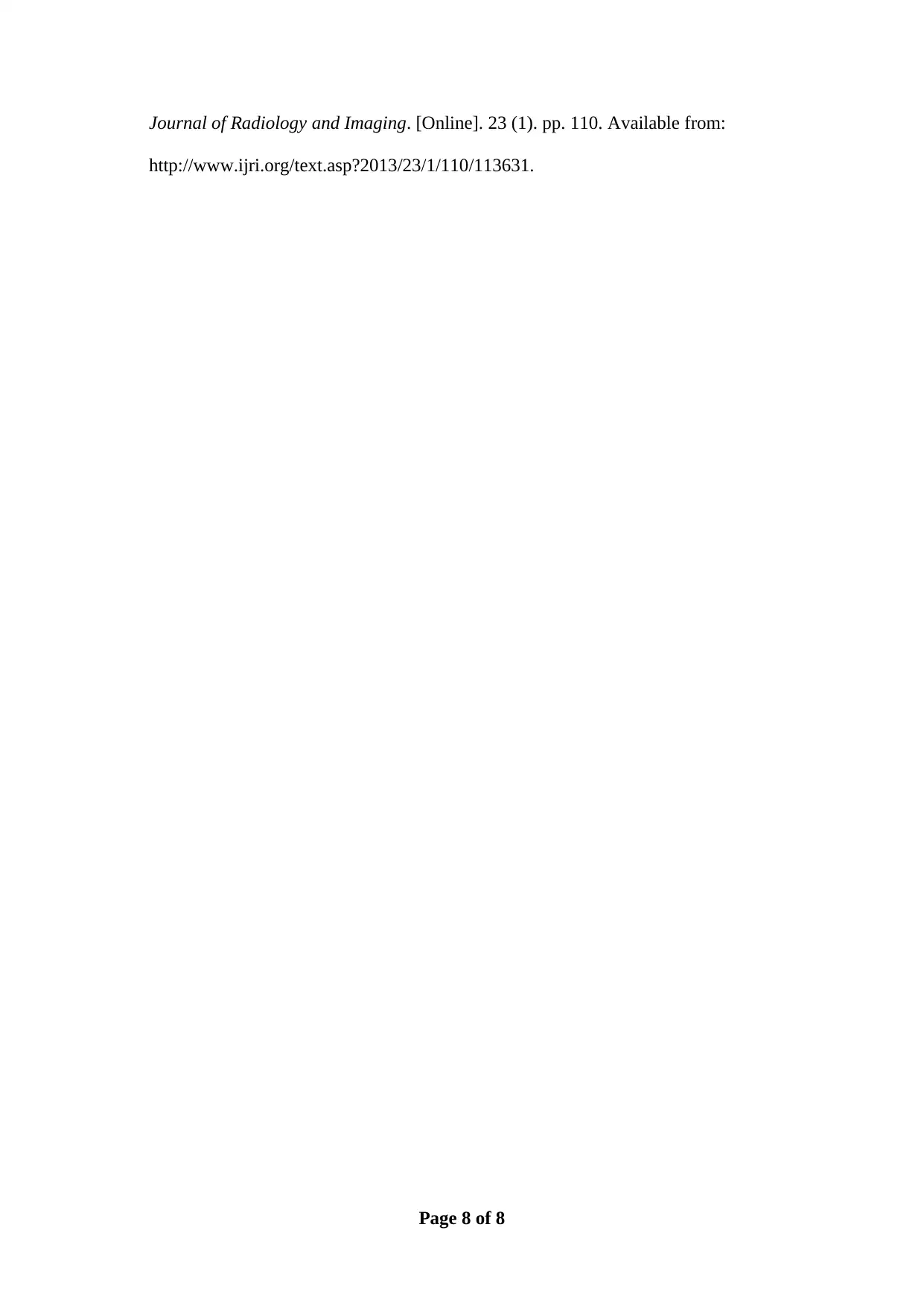
Journal of Radiology and Imaging. [Online]. 23 (1). pp. 110. Available from:
http://www.ijri.org/text.asp?2013/23/1/110/113631.
Page 8 of 8
http://www.ijri.org/text.asp?2013/23/1/110/113631.
Page 8 of 8
1 out of 8
Your All-in-One AI-Powered Toolkit for Academic Success.
+13062052269
info@desklib.com
Available 24*7 on WhatsApp / Email
![[object Object]](/_next/static/media/star-bottom.7253800d.svg)
Unlock your academic potential
Copyright © 2020–2025 A2Z Services. All Rights Reserved. Developed and managed by ZUCOL.
